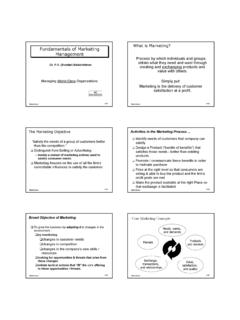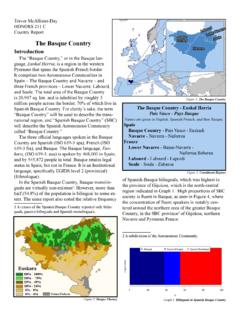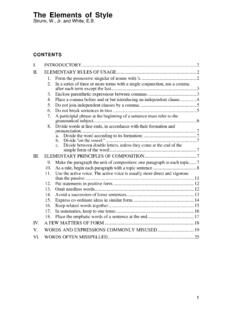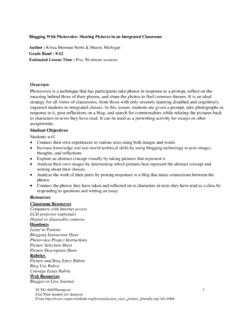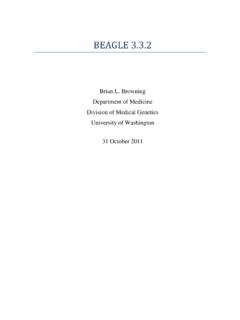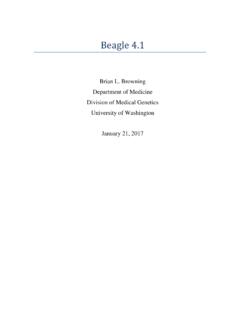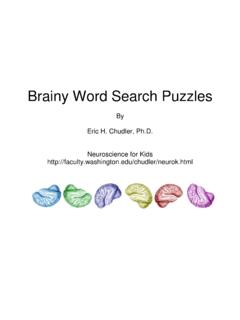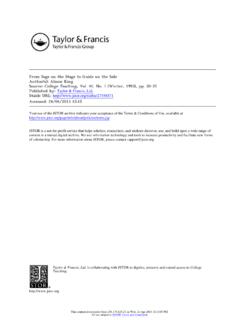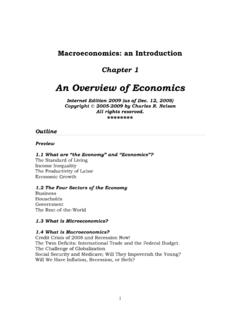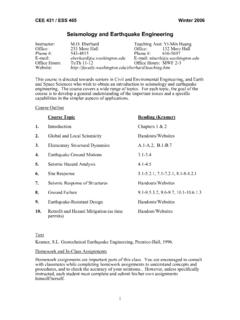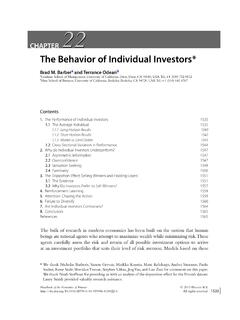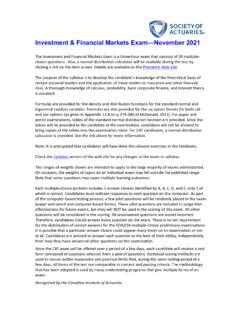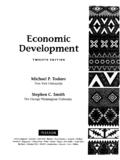Transcription of Econ 422 Summer 2006 Final Exam Solutions
1 Econ 422 Summer 2006 Final Exam Solutions This is a closed book exam. However, you are allowed one page of notes (double-sided). Answer all questions. For the numerical problems, if you make a computational error you may still receive full credit if you provide the correct formula for the problem. Total points = 115 (plus 5 extra credit points). You have 2 hours to complete the exam. Good luck. I. Risk and Return (25 points. Multiple choice questions: points each) 1. Which of the following portfolios have the least risk? A) A portfolio of Treasury bills B) A portfolio of long-term United States Government bonds C) Portfolio of common stocks of small firms D) None of the above A. 2. What has been the average annual nominal rate of return on a portfolio of common stocks over the past 101 years (from 1900 to 2003)?
2 A) Less than 1% B) Between 1% and 4% C) Between 4% and 8% D) greater than 8% D. 3. If the average annual rate of return for common stocks is , and treasury bills is , what is the average market risk premium? A) B) C) D) None of the above C. - = 4. What has been the standard deviation of returns of common stocks during the period between 1900 and 2003? A) B) C) D) A. 5. The portion of the risk that can be eliminated by diversification is called: A) market risk B) Unique risk C) Interest rate risk D) Default risk B. 6. As the number of stocks in a portfolio is increased: A) Unique risk decreases and approaches to zero B) market risk decrease C) Unique risk decreases and becomes equal to market risk D) Total risk approaches to zero A. 7. Stock X has a standard deviation of return of 10%.
3 Stock Y has a standard deviation of return of 20%. The correlation coefficient between stocks is If you invest 60% of the funds in stock X and 40% in stock Y, what is the standard deviation of a portfolio? A) 10% B) 20% C) D) None of the above C. 222221/ 2( ) ( )( ) ( )2( )( )( )( )( ) ( ) =++=== 8. If the standard deviation of returns of the market is 20% and the beta of a well-diversified portfolio is , calculate the standard deviation of the portfolio: A) 30% B) 20% C) 10% D) none of the above A. A well diversified portfolio has ( ) === 9. Briefly explain the difference between beta as a measure of risk and variance as a measure of risk. (5 points) The variance of returns represents the total risk of an asset how much, on average, that returns deviate from the average return.
4 Beta measures portfolio risk. That is, beta for an asset, with respect to a given portfolio, represents the contribution of the asset to the variability of a portfolio. The higher is beta, the higher is the contribution to portfolio risk. II. Portfolio Theory (28 points, 4 points each) Consider portfolios of three assets: Amazon stock (stock A), Boeing stock (stock B) and T-bills (risk-free asset). Assume the following information [] , [] () ,() (, ) RSD RCORR R Rr====== Transfer the diagram below to your blue book and use it to answer the following questions. SDPortfolio ERAmazonBoeingT-BillsAmaxon+T-BillsBoein g+T-Bills a. Let Axdenote the share of wealth in Amazon stock and 1Ax denote the share of wealth in T-Bills. Using the information in the diagram, sketch the portfolio expected return and standard deviation values for portfolios of T-bills and Amazon stock for values of Axbetween 0 and b.
5 Let Bxdenote the share of wealth in Boeing stock and 1Bx denote the share of wealth in T-Bills. Using the information in the diagram, sketch the portfolio expected return and standard deviation values for portfolios of T-bills and Boeing stock for values of Bxbetween 0 and See above graph for answers to a. and b. c. What are the values of Sharpe s slope for Amazon and Boeing stock? Using Sharpe s slope, which stock provides better investment opportunities when combined with T-Bills? []Sharpe's slope = () : : rSD R = = Amazon and T-Bills provides the better investment opportunities when combined with T-Bills. d. Find the portfolio of T-Bills and Amazon stock that has a target expected return of What is the standard deviation of this portfolio?
6 [] []( []) [] () ( ) AfAAfpAAERrERr x ERrxERrSD Rx =+ === == = e. The curved line in the diagram represents expected return and standard deviation values for portfolios of Amazon and Boeing stock. Using this curved line, indicate the location of the efficient portfolios of Amazon and Boeing stock. Risky asset only ERPortfolio SDSet of efficient risky asset portfolios consists of all portfolios above the minimum variance portfolioMinimum variance portfolio f. The curved line in the above diagram is based on (,) R R=. Sketch what the curve would look like if (,) 1 ABCORR R R= or (,)1 ABCORR R R= . Risky Asset SDPortfolio ERCORR = 1 CORR = -1 g. Graph the expected return and standard deviation values for efficient portfolios consisting of T-Bills, Amazon stock and Boeing stock.
7 On this graph, indicate a portfolio that would be chosen by a very risk averse individual and a portfolio that would be chosen by a very risk tolerant individual. II. The Capital Asset Pricing Model (CAPM) (25 points) 1. Assume that the T-Bill rate is 4 percent, and the expected return on the market portfolio ( S&P 500) is 12 percent. Using the CAPM, answer the following (4 points each): a. Draw a graph showing how the expected return on any asset varies with its beta ( ). That is, draw the security market line (SML). The SML gives the relationship []([ ] )fMfER rERr =+ . For the given data, the SML equation is [ ] ( ) ( )ER =+ =+ Graphically, this relationship is shown below. b. What is the risk premium on the market portfolio? [] slope of SMLMfERr = == c. What is the expected return on an asset with a beta of [ ] ( ) ( ) + = d.
8 If an investment project with a beta of offers an expected return of percent, should you do the project? Briefly explain why or why not. The required rate of return from the CAPM is [ ] ( ) + = Since the project s expected rate of return of is less than , using the IRR rule you should not do the project. e. If the market expects a return of percent from XYZ stock, what is its beta? ( ) =+ == 2. The following table shows risk estimates for the monthly returns on Starbucks stock, the Fidelity Magellan mutual fund, and the S&P 500 index: Asset SD(R) Beta (relative to S&P 500) Starbucks Fidelity Magellan S&P 500 Index For Starbucks and Fidelity Magellan, what portion of total risk is market risk and what portion is unique risk?
9 (5 points) The relationship between total risk and market risk is given by 222222()( ) ()total risk = market risk + unique risk()() market risk portion()()MMMVRVRVVRSDRRVRSDR =+== = Using the above, we have 22222222222222() ( ) ()( )() ( ) ()( )SBUXMSBUXSBUXFMMSBUXFMSD RRSD RSD RRSD R ====== III. market Efficiency (12 points, 4 points each) 1. State the efficient markets hypothesis , and name the three types of market efficiency. market prices of assets reflect all currently available information and provide a fair valuation. The three forms of market efficiency are: weak form, semi-strong form and strong form. 2. On 17 July 2004, ABC Corporation reported an increase of 2 cents in earnings per share (EPS). Nevertheless, the price of the stock dropped by $ In contrast, on the same day, the DEF Company reported a decrease of 3 cents, in its EPS, but the stock price rose by $ A journalist wrote that since this is the only new information received on 17 July about ABC and DEF, this proves that the stock market is inefficient.
10 Is the journalist s statement correct? The journalist is not necessarily correct. What is important for market efficiency is the expectations of the market about the EPS prior to earnings announcement. For ABC, if the increase of 2 cents in EPS is less than what the market expected then the information revealed in the EPS announcement is new information (bad news) and the stock should drop. Similarly, for DEF if the decrease of 3 cents in EPS is smaller than what the market expected then this is good news and the price of DEF should rise. 3. Two years after Monkey Business Corporation (MBC) went public, it was found that the company tampered with the accounting reports. As a result of this finding, the price of the company s stock fell by 80% the next day. Does the sharp fall in price violate market efficiency?
